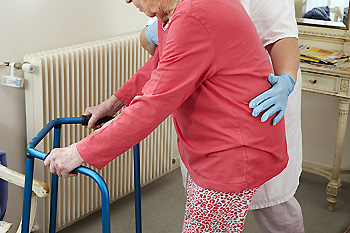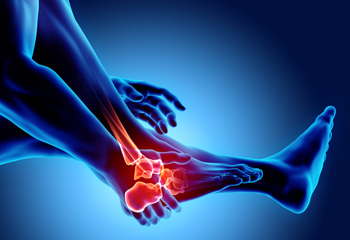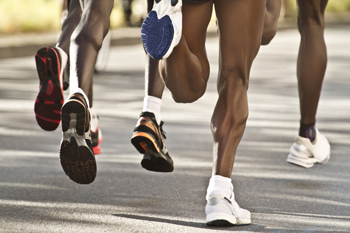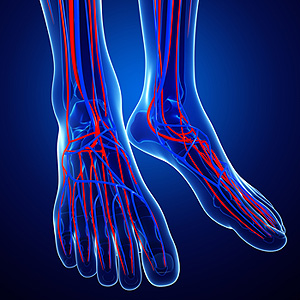December 2020
Preventing Falls Outdoors
 It is common for people to spend more time enjoying the outdoors when the weather is warm. However, falling episodes may not decrease while outside. There are many methods that can be implemented which can help to prevent falling. These can include wearing shoes that have rubber soles and flat heels, which can help to improve traction and stability. Additionally, keeping walkways and stairs free of clutter can help to prevent tripping. Walking with another person can be helpful, as they can assist you if you fall. Falling can affect the feet in numerous ways, and it is suggested that you consult with a podiatrist for more fall prevention techniques.
It is common for people to spend more time enjoying the outdoors when the weather is warm. However, falling episodes may not decrease while outside. There are many methods that can be implemented which can help to prevent falling. These can include wearing shoes that have rubber soles and flat heels, which can help to improve traction and stability. Additionally, keeping walkways and stairs free of clutter can help to prevent tripping. Walking with another person can be helpful, as they can assist you if you fall. Falling can affect the feet in numerous ways, and it is suggested that you consult with a podiatrist for more fall prevention techniques.
Preventing falls among the elderly is very important. If you are older and have fallen or fear that you are prone to falling, consult with Dr. Lee R. Stein from Lake Shore Foot & Ankle, PC. Our doctor will assess your condition and provide you with quality advice and care.
Every 11 seconds, an elderly American is being treated in an emergency room for a fall related injury. Falls are the leading cause of head and hip injuries for those 65 and older. Due to decreases in strength, balance, senses, and lack of awareness, elderly persons are very susceptible to falling. Thankfully, there are a number of things older persons can do to prevent falls.
How to Prevent Falls
Some effective methods that older persons can do to prevent falls include:
- Enrolling in strength and balance exercise program to increase balance and strength
- Periodically having your sight and hearing checked
- Discuss any medications you have with a doctor to see if it increases the risk of falling
- Clearing the house of falling hazards and installing devices like grab bars and railings
- Utilizing a walker or cane
- Wearing shoes that provide good support and cushioning
- Talking to family members about falling and increasing awareness
Falling can be a traumatic and embarrassing experience for elderly persons; this can make them less willing to leave the house, and less willing to talk to someone about their fears of falling. Doing such things, however, will increase the likelihood of tripping or losing one’s balance. Knowing the causes of falling and how to prevent them is the best way to mitigate the risk of serious injury.
If you have any questions, please feel free to contact one of our offices located in Chicago, Highland Park, and Uptown, IL . We offer the newest diagnostic and treatment technologies for all your foot care needs.
What Are the Early Symptoms of Rheumatoid Arthritis?
 Rheumatoid arthritis (RA) is an autoimmune condition that causes the body’s immune system to attack its own healthy tissue, including the lining of joints. This leads to initial symptoms such as joint pain, swelling, stiffness, redness, warmth around the affected joints, and morning stiffness in the joints that lasts longer than 30 minutes. Typically, the smaller joints, such as those in the feet, are affected first. Over time, rheumatoid arthritis can progress, deteriorating the joint cartilage, eroding bone tissue, and restricting the affected joint’s range of motion. If you have rheumatoid arthritis that is affecting the joints of your feet and ankles, it is suggested that you seek the care of a podiatrist.
Rheumatoid arthritis (RA) is an autoimmune condition that causes the body’s immune system to attack its own healthy tissue, including the lining of joints. This leads to initial symptoms such as joint pain, swelling, stiffness, redness, warmth around the affected joints, and morning stiffness in the joints that lasts longer than 30 minutes. Typically, the smaller joints, such as those in the feet, are affected first. Over time, rheumatoid arthritis can progress, deteriorating the joint cartilage, eroding bone tissue, and restricting the affected joint’s range of motion. If you have rheumatoid arthritis that is affecting the joints of your feet and ankles, it is suggested that you seek the care of a podiatrist.
Because RA affects more than just your joints, including the joints in your feet and ankles, it is important to seek early diagnosis from your podiatrist if you feel like the pain in your feet might be caused by RA. For more information, contact Dr. Lee R. Stein of Lake Shore Foot & Ankle, PC. Our doctor will assist you with all of your podiatric concerns.
What Is Rheumatoid Arthritis?
Rheumatoid Arthritis (RA) is an autoimmune disorder in which the body’s own immune system attacks the membranes surrounding the joints. Inflammation of the lining and eventually the destruction of the joint’s cartilage and bone occur, causing severe pain and immobility.
Rheumatoid Arthritis of the Feet
Although RA usually attacks multiple bones and joints throughout the entire body, almost 90 percent of cases result in pain in the foot or ankle area.
Symptoms
- Swelling and pain in the feet
- Stiffness in the feet
- Pain on the ball or sole of feet
- Joint shift and deformation
Diagnosis
Quick diagnosis of RA in the feet is important so that the podiatrist can treat the area effectively. Your doctor will ask you about your medical history, occupation, and lifestyle to determine the origin of the condition. Rheumatoid Factor tests help to determine if someone is affected by the disease.
If you have any questions please feel free to contact one of our offices located in Chicago, Highland Park, and Uptown, IL . We offer the newest diagnostic and treatment technologies for all your foot and ankle needs.
Heel Pain Can Be Treated!
What Is Jogger's Foot?
 Jogger’s foot is another term for medial plantar neuropraxia, an injury in which the medial plantar nerve that gives sensation to the bottom of the foot becomes compressed due to repetitive injury to the area. As its name suggests, jogger’s foot usually affects joggers, as well as long distance and marathon runners. People who have flat feet are at an increased risk of developing this injury because a flat foot causes more pressure and stretch to be placed on the medial plantar nerve, as the foot makes more forceful contact with the ground. Symptoms of jogger’s foot include chronic pain on the middle portion of the inside of the foot, an ache in the arch of the foot, a burning sensation in the heel, and tenderness over the area where the nerve is compressed. If you are experiencing pain in your foot, it is suggested that you seek the care of a podiatrist.
Jogger’s foot is another term for medial plantar neuropraxia, an injury in which the medial plantar nerve that gives sensation to the bottom of the foot becomes compressed due to repetitive injury to the area. As its name suggests, jogger’s foot usually affects joggers, as well as long distance and marathon runners. People who have flat feet are at an increased risk of developing this injury because a flat foot causes more pressure and stretch to be placed on the medial plantar nerve, as the foot makes more forceful contact with the ground. Symptoms of jogger’s foot include chronic pain on the middle portion of the inside of the foot, an ache in the arch of the foot, a burning sensation in the heel, and tenderness over the area where the nerve is compressed. If you are experiencing pain in your foot, it is suggested that you seek the care of a podiatrist.
Sports related foot and ankle injuries require proper treatment before players can go back to their regular routines. For more information, contact Dr. Lee R. Stein of Lake Shore Foot & Ankle, PC. Our doctor can provide the care you need to keep you pain-free and on your feet.
Sports Related Foot and Ankle Injuries
Foot and ankle injuries are a common occurrence when it comes to athletes of any sport. While many athletes dismiss the initial aches and pains, the truth is that ignoring potential foot and ankle injuries can lead to serious problems. As athletes continue to place pressure and strain the area further, a mild injury can turn into something as serious as a rupture and may lead to a permanent disability. There are many factors that contribute to sports related foot and ankle injuries, which include failure to warm up properly, not providing support or wearing bad footwear. Common injuries and conditions athletes face, including:
- Plantar Fasciitis
- Plantar Fasciosis
- Achilles Tendinitis
- Achilles Tendon Rupture
- Ankle Sprains
Sports related injuries are commonly treated using the RICE method. This includes rest, applying ice to the injured area, compression and elevating the ankle. More serious sprains and injuries may require surgery, which could include arthroscopic and reconstructive surgery. Rehabilitation and therapy may also be required in order to get any recovering athlete to become fully functional again. Any unusual aches and pains an athlete sustains must be evaluated by a licensed, reputable medical professional.
If you have any questions please feel free to contact one of our offices located in Chicago, Highland Park, and Uptown, IL . We offer the newest diagnostic and treatment technologies for all your foot and ankle needs.
Scans to Detect Peripheral Artery Disease
 Computed tomography angiography (CTA) and magnetic resonance angiography (MRA) are two kinds of noninvasive imaging studies that can be used to visualize the blood flow in different areas of your body, including your lower limbs. A podiatrist may request that you undergo one of these imaging studies if they suspect that you might have peripheral artery disease, a condition that causes poor circulation to the lower limbs. Both of these tests require the patient to lie down on a motorized bed that moves through a scanner, which takes images of your lower legs. CTAs require the injection of an intravenous contrasting agent and the use of radiation in order to see your blood flow, while an MRA may or may not require the use of a contrasting agent, but does not use radiation. For more information about these and other tests to assess blood flow in the lower limbs, please speak with a podiatrist.
Computed tomography angiography (CTA) and magnetic resonance angiography (MRA) are two kinds of noninvasive imaging studies that can be used to visualize the blood flow in different areas of your body, including your lower limbs. A podiatrist may request that you undergo one of these imaging studies if they suspect that you might have peripheral artery disease, a condition that causes poor circulation to the lower limbs. Both of these tests require the patient to lie down on a motorized bed that moves through a scanner, which takes images of your lower legs. CTAs require the injection of an intravenous contrasting agent and the use of radiation in order to see your blood flow, while an MRA may or may not require the use of a contrasting agent, but does not use radiation. For more information about these and other tests to assess blood flow in the lower limbs, please speak with a podiatrist.
Vascular testing plays an important part in diagnosing disease like peripheral artery disease. If you have symptoms of peripheral artery disease, or diabetes, consult with Dr. Lee R. Stein from Lake Shore Foot & Ankle, PC. Our doctor will assess your condition and provide you with quality foot and ankle treatment.
What Is Vascular Testing?
Vascular testing checks for how well blood circulation is in the veins and arteries. This is most often done to determine and treat a patient for peripheral artery disease (PAD), stroke, and aneurysms. Podiatrists utilize vascular testing when a patient has symptoms of PAD or if they believe they might. If a patient has diabetes, a podiatrist may determine a vascular test to be prudent to check for poor blood circulation.
How Is it Conducted?
Most forms of vascular testing are non-invasive. Podiatrists will first conduct a visual inspection for any wounds, discoloration, and any abnormal signs prior to a vascular test.
The most common tests include:
- Ankle-Brachial Index (ABI) examination
- Doppler examination
- Pedal pulses
These tests are safe, painless, and easy to do. Once finished, the podiatrist can then provide a diagnosis and the best course for treatment.
If you have any questions, please feel free to contact one of our offices located in Chicago, Highland Park, and Uptown, IL . We offer the newest diagnostic and treatment technologies for all your foot care needs.
Blog Archives
- July 2025
- June 2025
- May 2025
- April 2025
- March 2025
- February 2025
- January 2025
- December 2024
- November 2024
- October 2024
- September 2024
- August 2024
- July 2024
- June 2024
- May 2024
- April 2024
- March 2024
- February 2024
- January 2024
- December 2023
- November 2023
- October 2023
- September 2023
- August 2023
- July 2023
- June 2023
- May 2023
- April 2023
- March 2023
- February 2023
- January 2023
- December 2022
- November 2022
- October 2022
- September 2022
- August 2022
- July 2022
- June 2022
- May 2022
- April 2022
- March 2022
- February 2022
- January 2022
- December 2021
- November 2021
- October 2021
- September 2021
- August 2021
- July 2021
- June 2021
- May 2021
- April 2021
- March 2021
- February 2021
- January 2021
- December 2020
- November 2020
- October 2020
- September 2020
- August 2020
- July 2020
- June 2020
- May 2020
- April 2020
- March 2020
- February 2020
- January 2020
- December 2019
- November 2019
- October 2019
- September 2019
- August 2019
- July 2019
- June 2019
- May 2019
- April 2019
- March 2019
- February 2019
- January 2019
- December 2018
- November 2018
- October 2018
- September 2018
- August 2018
- July 2018








